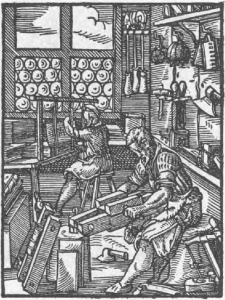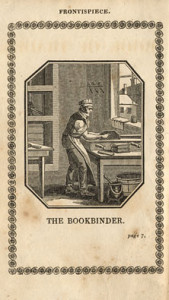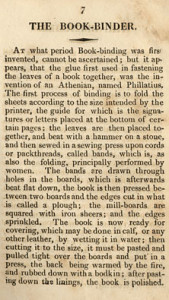
One of our favorite illustrations at the American Bookbinders Museum is an engraving from 1694 done by the Dutch artist Jan Luyken (or Luiken). Seen at left, “De Boeckbinder” (The Bookbinder), is one of a hundred trades detailed in Luyken’s Het Menslyk Bedryft (The Book of Trades).
Luyken is remembered as a painter and skilled engraver in the period after Rembrandt. He was also a poet and a mystic, one whose work ranged from love-poems (written when he was a young man) to devotional work. In 1675, when he was 26, “the Lord appeared in [Luyken’s] heart in a powerful manner. Afire with the love of God, he forsook his old, bad company” to join the followers of Jakob Böhme (1), an influential German theologian. His work thereafter would always be heavily influenced by Böhme’s philosophy.
In Het Menslyk Bedryft, Luyken included trades from needle-maker to prince, farmer to teacher, and in addition to the bookbinder, others in the book-making trade: paper-maker, engraver, and printer. The book’s engravings were done by Jan and his son Kaspar, and each illustration had a devotional poem which emphasized the ephemeral nature of life, and the foolishness of anyone who gave more attention to worldly, than religious, matters.
In De Boeckbinder we have a pretty faithful rendering of a bookbinder’s shop or studio. Four important pieces of binding equipment are visible: the glue pot (bottom left), the sewing frame on the table above it, the beating hammer being wielded at top center, and (bottom right) the plow, used for trimming the edges of the newly-laced book. The top text roughly translates as: The eye of the eternal being / Can read the book of your heart.
The text below the engraving reads:
If knowledge lay secretly in the corners,
Where the path led to heaven,
It would be worthwhile to search the world:
However now that man has been clearly taught,
In the holy scripture, given by God,
He loathes the righteous life. (2)
Verses that accompanied the other illustrated trades in the book were of a similarly stern nature.
Luyken was not the first to create a catalog of the trades of his time and place. More than a hundred years before, woodcut artist Jost Amman and poet Hans Sachs produced Das Ständebuche, which appeared in Germany in 1564. Again, bookbinders appear (see the illustration below), and although the workplace seems a little more cluttered than the one in Luyken’s illustration, the tools, including the sewing frame and press and plow, are the same.
Amman and Sach’s book included verses as well, but where Luyken’s verses were sternly devotional, Sach’s verses accompanying Amman’s illustrations were a little more playful.
I bind all sorts of books
Religious and worldly, Large and small
In parchment or plain boards
And fit it with a good covering
And clasps and tool it with decorations
I even flatten them at the beginning
And many I gild on the edges
With which I earn much money. (3)
As late as the Victorian age books of trades continued to be popular. The book of trades; or, Familiar descriptions of the most useful trades, manufactures, and arts practised in England : and the manner in which the workmen perform their various employments, was published in 1829, and appears to have been one of many such books published for children (all of them, confusingly, with titles like The Book of Trades, or Circle of the Useful Arts (1835), and The Book of Trades, or Library of the Useful Arts (1804) (4). The 1829 edition featured a bookbinder on the frontispiece and a description later in the book.
By this time verse had been abandoned for a more practical description of the binding process itself. No judgment is made as to the state of the binder’s soul, as in Luyken; nor does the description carry the overtones of pride in workmanship that Sach’s verse does. By 1829 it’s all about the process.
(1) Kort Verhaal van het Godvrugtig leven en Zalig Afsterven van Joannes Luiken (1712) http://gameo.org/index.php?title=Luiken,_Jan_(1649-1712)
(2) The Mirror of the Human Occupation, Jan and Kaspar Luyken, translation by Josephine V. Brown, with editorial assistance from William G. Stryker http://www.pitts.emory.edu/dia/detail.cfm?ID=116987
(3) http://pressbengel.blogspot.com/2010/12/bookbinder-and-bookbinding-in-two-books.html
(4) http://digital.library.wisc.edu/1711.dl/DLDecArts.BkTrades




